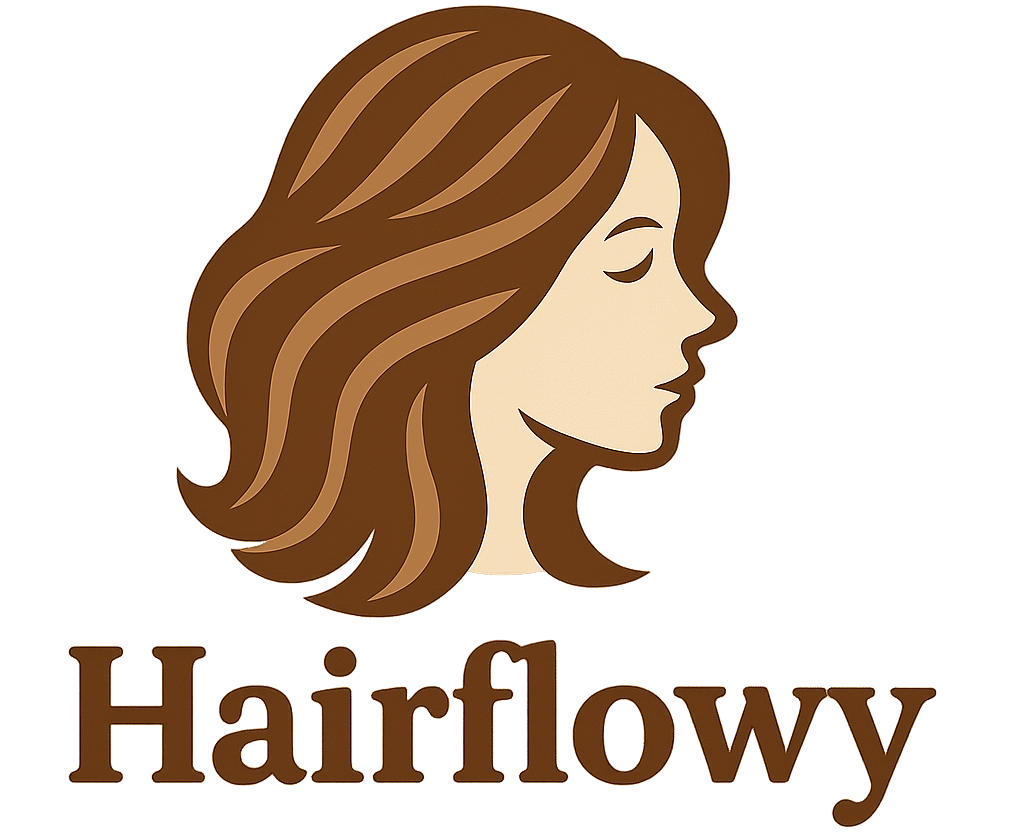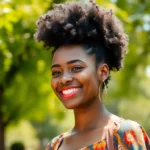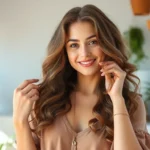We believe that age is just a number when it comes to stunning curly hairstyles. If you’re over 60 and blessed with natural curls or considering embracing them, you’re in for a treat. The industry of curly hair styling has evolved dramatically, offering countless options that celebrate texture while providing sophistication and elegance.
Gone are the days when women over 60 felt limited to short, conservative cuts. Today’s curly hairstyles for mature women range from playful pixies to glamorous shoulder-length styles that enhance natural beauty and boost confidence. Whether you’re dealing with thinning hair, changing texture, or simply want a fresh new look, the right curly style can take years off your appearance.
We’ll explore the most flattering curly cuts and styling techniques specifically designed for women over 60. From low-maintenance options to statement-making styles, you’ll discover how to work with your hair’s natural texture to create looks that are both age-appropriate and incredibly chic.
Embrace Your Natural Texture: Why Curly Hairstyles Over 60 Are Perfect for You
Natural curls offer incredible advantages for women over 60 that we often overlook in our search for straight styles. Curly hair naturally creates volume and body that becomes increasingly valuable as our hair tends to thin with age. The texture adds instant dimension and movement without requiring extensive styling products or heated tools that can damage mature hair.
Volume creation happens effortlessly with curly textures because each curl lifts away from the scalp naturally. Fine hair that has lost density over the years gains the appearance of fullness through curls’ three dimensional structure. We don’t need to tease or backcomb our hair to achieve the lift that curls provide automatically.
Styling time decreases significantly when we work with our natural curl pattern instead of fighting against it. Air drying becomes a viable option for curly haired women over 60 because the texture looks polished without heat styling. Daily maintenance requires only a few curl improving products and gentle scrunching motions.
Face framing benefits emerge naturally from curly hairstyles as the curves soften angular features that become more pronounced with age. Curls create gentle shadows and highlights around the face that blur fine lines and add youthful movement. The organic shape of curls draws attention to our eyes and cheekbones rather than focusing on areas we might prefer to minimize.
Hair health improves when we embrace natural curls because we reduce chemical processing and heat damage. Curly hair tends to be more fragile than straight hair so gentle handling preserves its integrity longer. Regular deep conditioning treatments work more effectively on curly textures because the hair shaft readily accepts moisture.
Professional styling becomes optional rather than necessary when we master our curl care routine. Home maintenance with the right products and techniques produces salon quality results for curly haired women over 60. We save both time and money by learning to enhance what nature already provided rather than constantly reshaping our hair into unnatural patterns.
Classic Curly Bob: The Timeless Choice for Mature Women
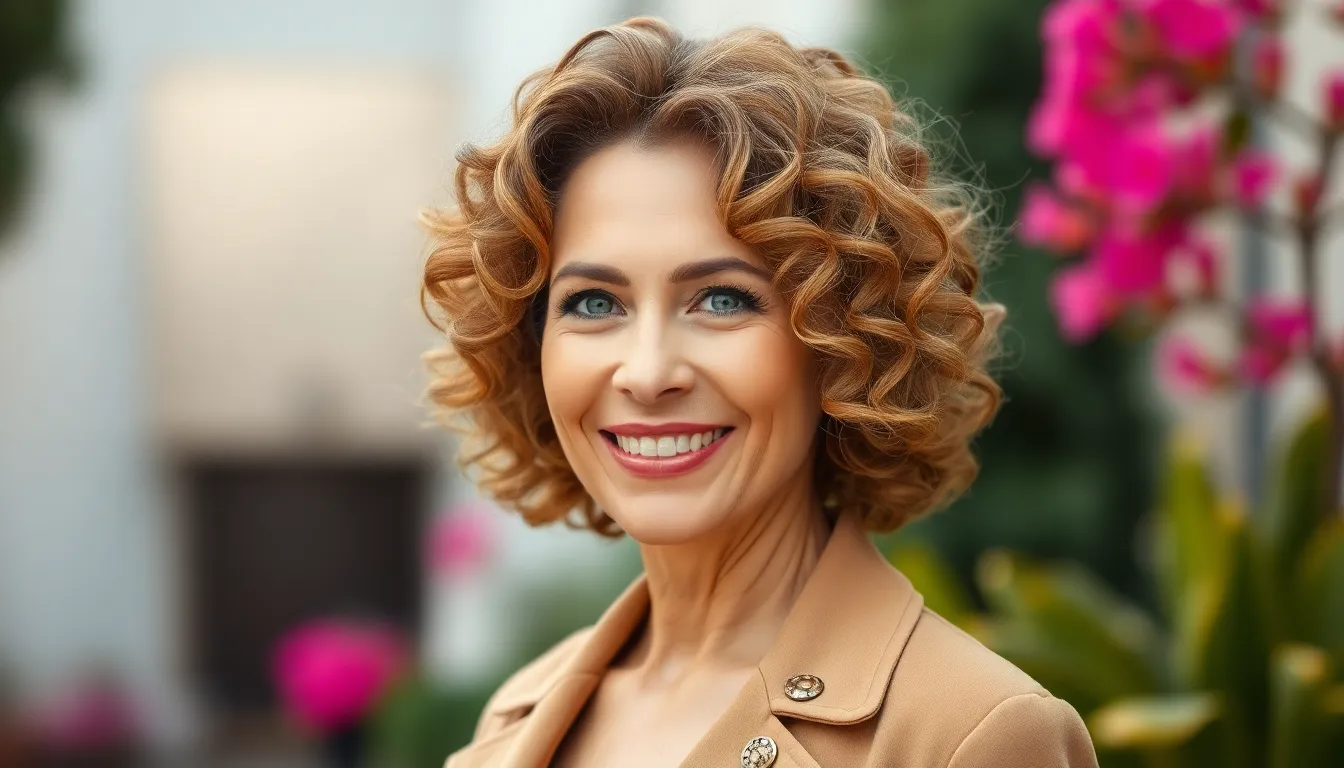
Jaw length curly bobs remain the most versatile hairstyle option for women over 60. This classic cut emphasizes natural curl patterns while maintaining a chic, youthful appearance that requires minimal daily maintenance. We’ve found that this style adapts beautifully to various curl types and face shapes, making it an ideal choice for mature women seeking both elegance and practicality.
Layered textures transform the basic curly bob into a ever-changing, voluminous style. These strategic layers enhance curl definition and create movement throughout the hair, making it appear thicker and more vibrant. Professional stylists incorporate these layers to soften the transition between grays and highlights, creating a natural, blended appearance that flatters mature skin tones.
Maintenance requirements for curly bobs focus on hydration and gentle care. Regular deep conditioning treatments keep curls healthy, defined, and frizz free throughout the week. We recommend avoiding harsh shampoos that strip natural oils, instead opting for sulfate free formulas that preserve moisture and curl integrity.
Color versatility makes the curly bob adaptable to personal preferences. Natural gray tones, highlighted accents, and blonde variations all enhance this style’s modern appeal while complementing mature facial features. The shorter length minimizes styling time significantly, making it perfect for active lifestyles or those preferring low maintenance routines.
Customization options include asymmetrical details and soft bangs for added personality. These variations provide extra edge while maintaining the classic bob’s timeless foundation. Face framing benefits from these subtle modifications help accentuate the eyes and cheekbones, creating a more youthful overall appearance.
Layered Curly Pixie Cut: Short and Sophisticated

Moving beyond traditional cuts, the layered curly pixie offers an ideal balance of sophistication and practicality for women embracing their curls. This versatile style celebrates natural texture while providing the low maintenance approach many mature women appreciate.
Benefits of Pixie Cuts for Curly Hair Over 60
Easy maintenance tops our list of advantages for choosing this sophisticated cut. We find that pixie styles require minimal daily styling, making them perfect for women who prefer spending less time on their hair routine.
Feature enhancement becomes particularly noticeable with curly pixie cuts. The shorter length frames your face beautifully, drawing attention to your eyes and cheekbones while adding an undeniably youthful touch to your overall appearance.
Styling versatility allows you to adapt this cut for various occasions. We recommend experimenting with different textures and curl patterns to create looks ranging from casual daytime styles to more polished evening appearances.
Volume creation works especially well for those experiencing thinning hair. Pixie cuts naturally create the illusion of fuller, thicker hair by eliminating the weight that can pull curls down and make hair appear flat.
Styling Tips for Curly Pixie Cuts
Moisturizing products form the foundation of successful curly pixie styling. We suggest applying curl defining creams or leave in conditioners to maintain moisture levels and prevent frizz throughout the day.
Strategic layering enhances both volume and texture in your pixie cut. Adding layers creates movement and dimension, particularly beneficial for women with thicker hair who want to avoid a heavy, weighed down appearance.
Twist cutting techniques provide additional dimension to your curls. We recommend discussing this cutting method with your stylist, as it can enhance curl formation and create more natural looking texture.
Scrunching methods work best when you use a soft T-shirt instead of a regular towel. Apply curl defining mousse to damp hair, then gently scrunch upward to encourage curl formation while minimizing frizz and breakage.
Shoulder-Length Curly Shag: Effortless Volume and Movement
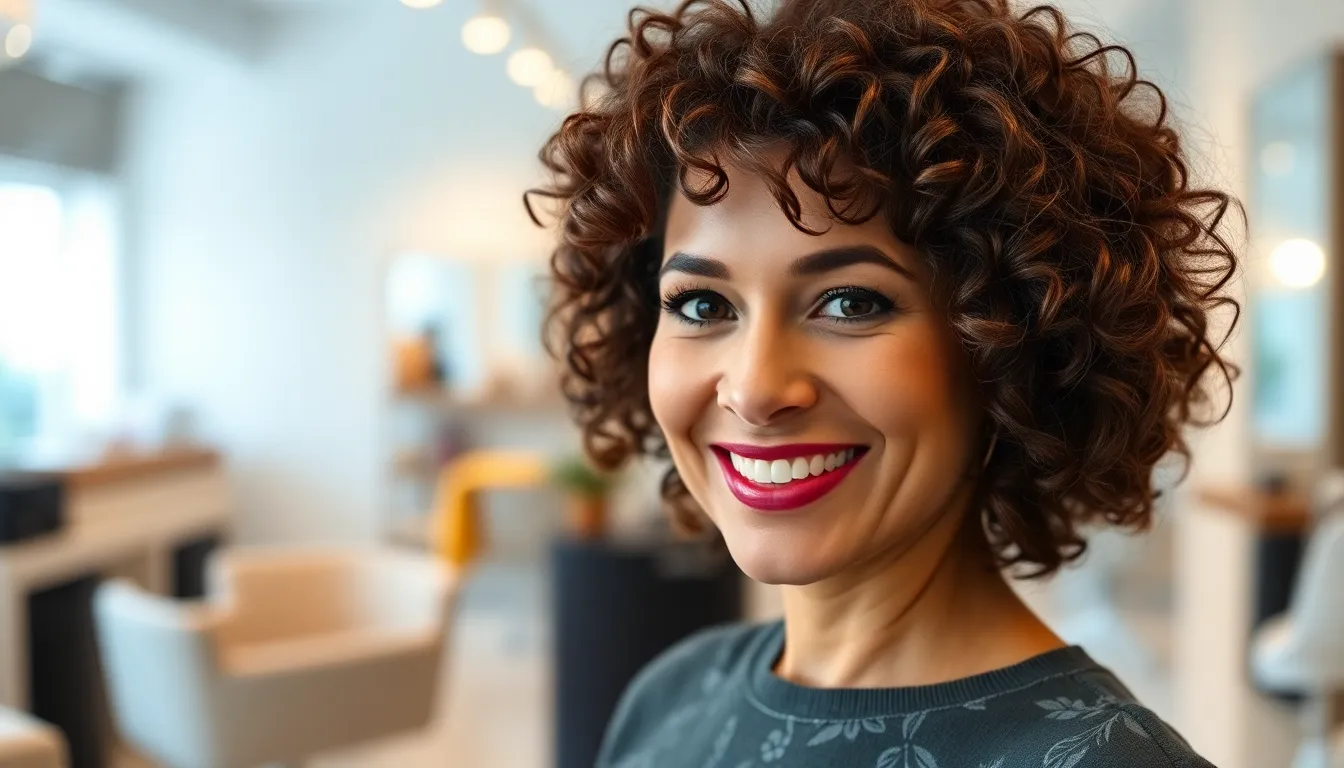
Shoulder-length curly shags combine the best of both worlds for women over 60, offering sophisticated style with minimal effort. This versatile cut delivers natural volume and ever-changing movement that flatters mature features while maintaining an effortlessly chic appearance.
How to Achieve the Perfect Curly Shag
Layered cuts form the foundation of every successful curly shag, creating essential volume and movement throughout your hair. We recommend asking your stylist for strategic layers that work with your natural curl pattern rather than against it.
Choose curl-improving products with moisturizing ingredients to define your curls without weighing them down. Curl creams and lightweight gels help maintain shape while adding shine and reducing frizz.
Apply products to damp hair using a scrunching motion from ends to roots. This technique encourages curl formation and prevents disrupting your natural texture.
Style with minimal effort by allowing your hair to air dry whenever possible. Air drying preserves the natural movement of curly shags while reducing heat damage that can lead to dryness and breakage.
Use twist cutting techniques during salon visits to enhance curl formation and create seamless layers. This specialized cutting method works with your curl pattern to produce more defined, bouncy curls.
Maintenance Tips for Curly Shag Hairstyles
Regular deep conditioning treatments keep curls hydrated and healthy, which is crucial for maintaining the effortless look of a curly shag. We suggest using moisturizing masks weekly to prevent dryness and enhance curl definition.
Avoid harsh sulfate shampoos that strip natural oils from curly hair. Gentle, sulfate-free formulas preserve moisture and prevent the frizz that can disrupt your shag’s natural texture.
Sleep on silk or satin pillowcases to reduce friction and prevent curl disruption overnight. This simple change helps maintain your style longer between washes.
Scrunch with a soft T-shirt instead of traditional towels to encourage curl definition while minimizing frizz and breakage. Cotton T-shirts are gentler on delicate curls than rough terry cloth towels.
Trim every 6-8 weeks to maintain the shape and prevent split ends from traveling up the hair shaft. Regular maintenance keeps your curly shag looking fresh and voluminous.
Curly Lob (Long Bob): The Modern Middle Ground
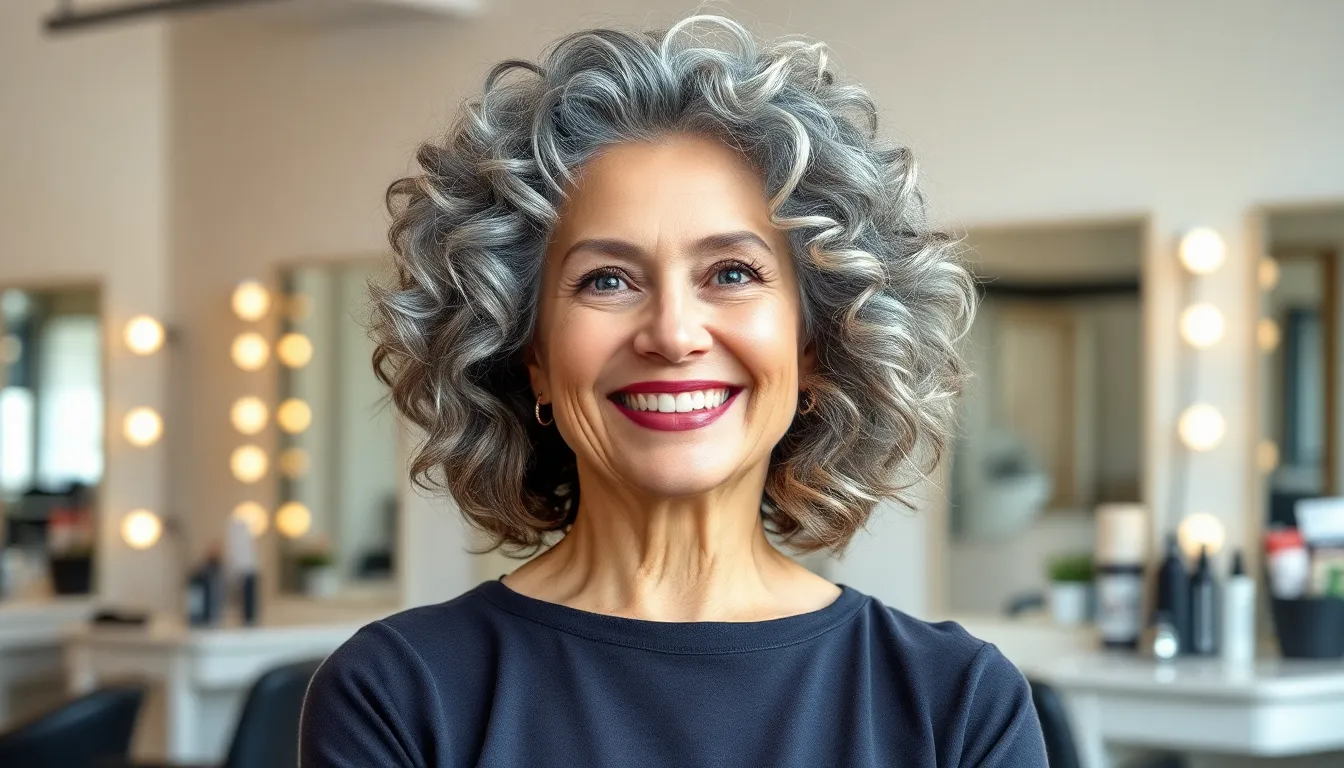
Finding the perfect balance between short and long becomes effortless with the curly lob. This versatile cut offers women over 60 an ideal solution that maintains length while providing the manageable benefits of a bob. We’ve found that this style works exceptionally well for those transitioning from longer hairstyles who aren’t ready to commit to shorter cuts.
Length typically falls somewhere between the chin and shoulders, creating an incredibly flattering silhouette. Most stylists recommend keeping the lob at collarbone length to maximize curl definition and movement. This strategic positioning allows curls to bounce naturally without overwhelming the face or appearing too youthful.
Layered textures transform the basic lob into a sophisticated style statement. We recommend asking your stylist for long layers throughout the cut to enhance your natural curl pattern. These layers create dimension and prevent the dreaded triangle shape that can occur with blunt cuts on curly hair.
Gray blending becomes seamless with the curly lob’s natural movement. The curl pattern helps soften the contrast between gray roots and colored lengths, making maintenance appointments less frequent. We’ve noticed that highlights and lowlights integrate beautifully within the layers, creating depth and richness.
Styling requires minimal effort while delivering maximum impact. Simply scrunch damp hair with a curl improving cream and allow it to air dry for effortless waves. We suggest applying products to soaking wet hair and then gently squeezing out excess water with a microfiber towel to encourage curl formation.
Face framing benefits make this cut universally flattering across different face shapes. The length draws attention to the jawline and cheekbones while the curls add softness around the eyes. We’ve observed that the lob particularly enhances oval and heart shaped faces by balancing proportions naturally.
Maintenance stays refreshingly simple with regular trims every 8 to 10 weeks. This schedule keeps the shape intact while preventing split ends from traveling up the hair shaft. We recommend focusing your conditioning treatments on the mid lengths and ends where curly hair tends to be driest.
Short Curly Afro: Celebrating Natural Texture and Beauty
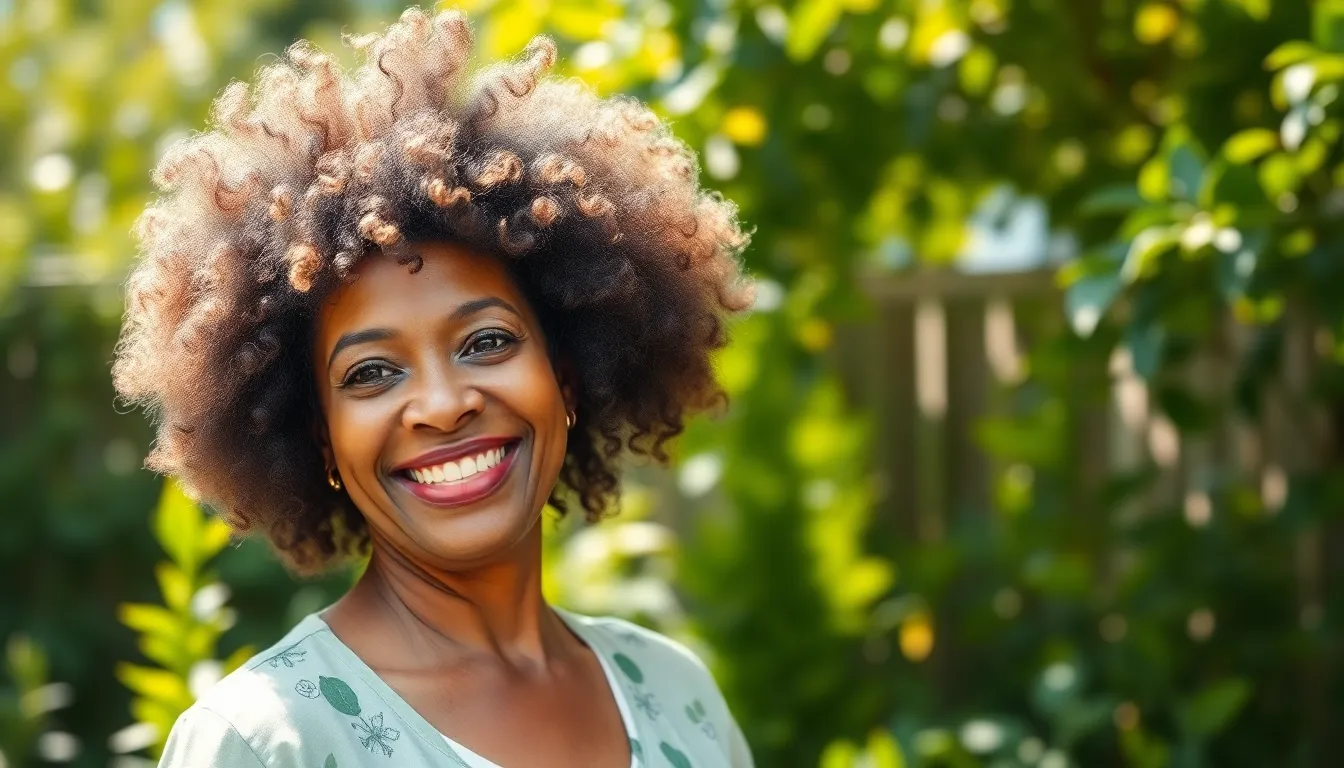
Embracing your natural curly afro creates a powerful statement of confidence and authenticity that’s particularly striking on women over 60. This gorgeous texture offers unmatched volume and dimension while requiring minimal manipulation to look absolutely stunning.
Improving Your Natural Curly Afro
Start with proper layering to create lift and shape that allows your curls to cascade effortlessly throughout your afro. Strategic cutting techniques help prevent the dreaded triangle shape while maintaining the full, rounded silhouette that makes afros so beautiful.
Focus on moisture retention since curly afros need consistent hydration to maintain their defined curl pattern and prevent dryness. Deep conditioning treatments once or twice weekly will keep your curls supple and reduce breakage that can thin out your natural texture.
Embrace twist cutting methods for thicker hair to add dimension and prevent your afro from appearing too dense or heavy. This technique works particularly well for coily textures and helps create more movement within the overall shape.
Regular trims every 6 to 8 weeks maintain healthy, full curls while removing damaged ends that can make your afro look frizzy or unkempt. Consistent maintenance keeps your natural texture looking vibrant and well defined.
Gentle styling techniques preserve your curl pattern and minimize manipulation that can cause breakage. Finger detangling on wet hair with plenty of conditioner protects delicate curls from damage while maintaining their natural formation.
Products for Healthy Curly Afro Hair
Moisturizing leave in conditioners provide essential hydration that curly afros desperately need to stay healthy and defined. Look for products containing natural oils like argan or jojoba that penetrate the hair shaft without weighing down your curls.
Light styling creams help maintain defined curls while preventing frizz that can make your afro appear unpolished. Apply these products to damp hair using praying hands method to smooth the product over your curls without disrupting their pattern.
Curl defining gels offer hold and definition for special occasions when you want your afro to look extra polished and controlled. Choose alcohol free formulas that won’t dry out your curls or create crunchy textures.
Gentle sulfate free shampoos cleanse your scalp and hair without stripping away the natural oils your curly afro needs to stay healthy. Co washing between shampoo sessions can provide additional moisture while removing light buildup.
Natural oils like coconut or olive oil seal moisture into your hair shaft and add shine to your curly afro texture. Apply small amounts to slightly damp hair focusing on the mid lengths and ends where curls tend to be driest.
Curly Hair with Bangs: Adding Youthful Flair

Bangs transform curly hairstyles for women over 60 by drawing attention to the eyes and softening facial features. They create a ever-changing element that adds movement and youthful energy to any curly cut.
Side-Swept Curly Bangs
Side-swept bangs complement curly hair by creating an asymmetrical frame that flatters most face shapes. We recommend this style because it offers versatility while maintaining the natural curl pattern throughout the hairline. Styling becomes effortless when you allow your curls to fall naturally to one side, creating soft movement that draws attention upward to your eyes and cheekbones.
These bangs work particularly well with shoulder-length curls and layered cuts, as they blend seamlessly into longer sections. Volume at the crown gets enhanced when side-swept bangs create lift and dimension. Maintenance requires minimal effort since the asymmetrical shape disguises any uneven curl formation that might occur between salon visits.
Curly Fringe Options
Curly fringes come in various styles that allow for customizable looks suited to individual preferences and face shapes. Blunt cuts create a bold statement that works beautifully with pixie cuts and short bobs, while wispy layered fringes offer a softer approach that complements longer curly styles.
We’ve found that curly fringes frame the face effectively while adding texture and movement to the overall hairstyle. Twist cutting techniques enhance curl definition in fringe areas, creating natural separation that prevents the heavy appearance sometimes associated with straight bangs. Regular trims every 6 to 8 weeks keep curly fringes looking fresh and prevent them from overwhelming facial features.
Moisturizing products become essential for maintaining curly bangs, as the shorter length can be more prone to dryness and frizz. Scrunching with a microfiber towel helps encourage curl formation while reducing breakage in these delicate areas.
Asymmetrical Curly Cuts: Contemporary and Edgy
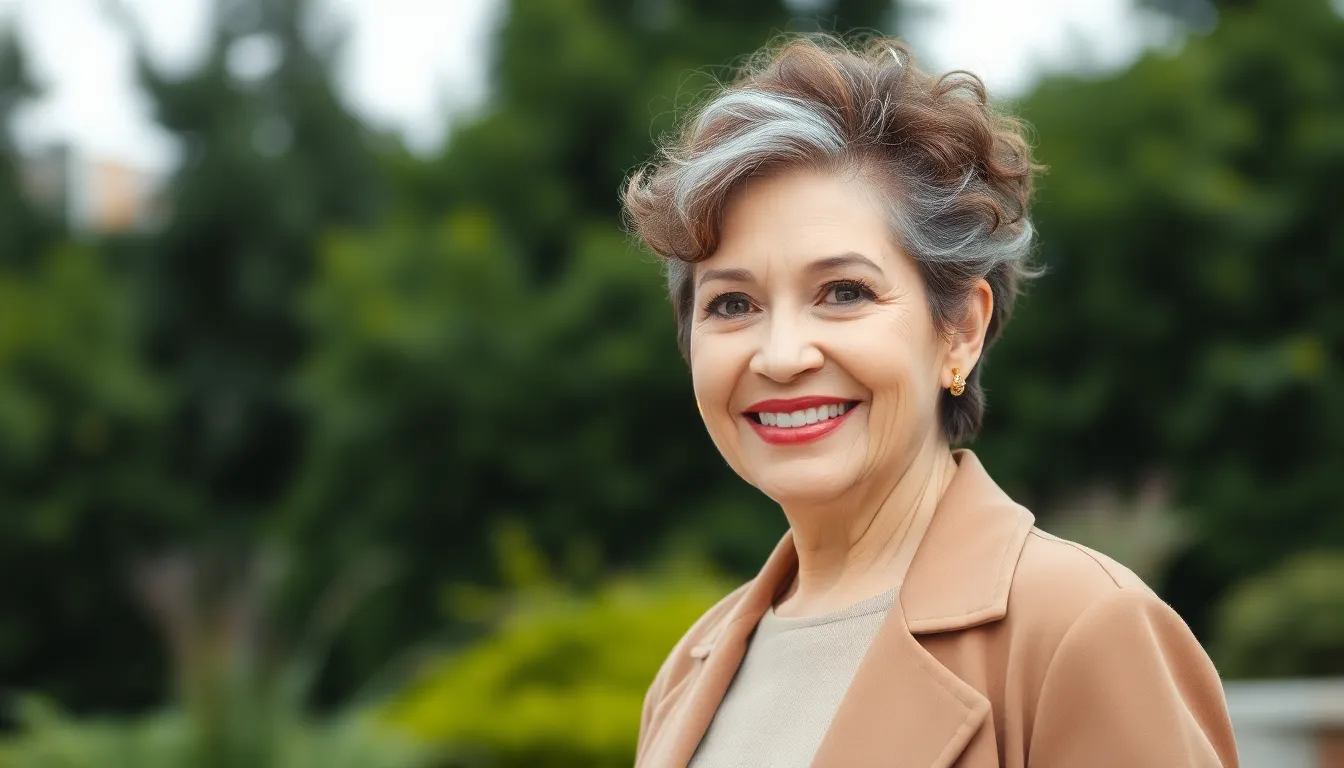
Asymmetrical curly bobs revolutionize the traditional bob by featuring varying lengths on each side, creating a modern twist that adds interest and dimension. We love how this style makes curls stand out even more while blending edginess with elegance. The uneven lengths create visual movement that draws the eye and adds a sophisticated, contemporary feel to your overall look.
Side parted asymmetrical styles offer a playful twist on traditional cuts while maintaining low maintenance appeal. Styling curls to enhance asymmetry creates depth and visual interest that’s perfect for naturally wavy or curly hair. We recommend this approach because it allows your natural texture to shine while adding an unexpected element that keeps your style fresh and current.
Silver curly hair with tapered sides combines color and cut for a sleek, contemporary appearance that’s both refined and edgy. This combination offers the perfect balance between embracing natural gray tones and incorporating modern styling techniques. The tapered sides create clean lines that contrast beautifully with the volume of curls on top.
Creating asymmetrical dimension works exceptionally well for women over 60 because it adds youthful energy without appearing trendy or inappropriate. Different lengths create natural movement that can soften facial features while drawing attention upward toward your eyes and cheekbones. We find that asymmetrical cuts also help camouflage any areas where hair might be thinning by redirecting focus to the fuller sections.
Maintenance for asymmetrical curly cuts requires strategic trimming every 6 to 8 weeks to preserve the intended shape and prevent the style from growing out unevenly. Professional stylists can adjust the lengths to maintain the asymmetrical balance while working with your natural curl pattern. Regular deep conditioning treatments become even more important with these cuts because the varying lengths need consistent moisture to maintain their intended shape and definition.
Styling Products Essential for Curly Hairstyles Over 60
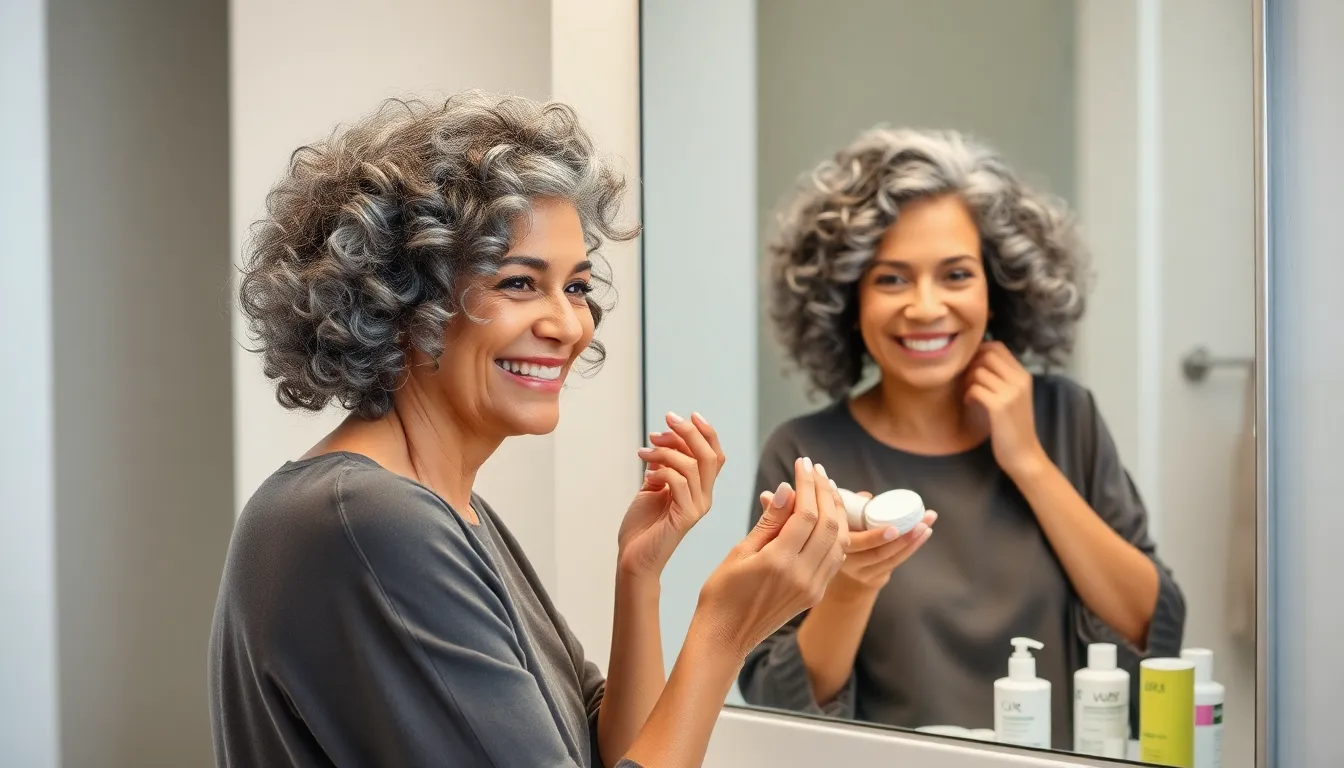
Proper products become crucial for maintaining healthy, defined curls as we age, especially when natural oils decrease and hair texture changes.
Curl-Defining Creams and Gels
Curl-defining creams and gels are crucial for older adults with curly hair, providing the structure and definition that keeps our curls looking vibrant and well-formed. These specialized products help manage frizz while offering the hold needed to maintain curl patterns throughout the day.
Moisturizing ingredients play a vital role in these formulations, with humectants like glycerin working to lock in moisture and keep our curls healthy. We recommend choosing products that combine curl definition with hydration, as aging hair requires both structure and nourishment.
Application techniques matter significantly when using these products. Distributing cream or gel through damp hair using the “praying hands” method helps coat each strand evenly without disrupting natural curl formation. Scrunching motions afterward encourage curl definition while preventing the crunchy texture that some gels can create.
Product layering can enhance results when we apply a lightweight cream first for moisture, followed by a small amount of gel for hold. This combination approach addresses both the hydration needs of mature curls and the definition requirements for polished styling.
Heat Protectants and Moisturizers
Heat protectant sprays are necessary when using styling tools to prevent the additional dryness and damage that commonly affects aging hair. These products create a barrier between our curls and high temperatures, preserving moisture and preventing brittleness.
Regular use of moisturizers becomes non-negotiable for mature curly hair, with deep conditioners and leave-in treatments helping maintain the hydration and elasticity that naturally decrease with age. Weekly deep conditioning sessions can restore moisture balance and improve curl spring.
Avoiding harsh shampoos and opting for sulfate-free options helps preserve our hair’s natural oils, keeping curls bouncy and soft rather than stripped and dry. Sulfate-free formulas clean gently while maintaining the moisture barrier that protects our curl structure.
Leave-in conditioners deserve special attention in our mature curl care routine. These products provide ongoing hydration between wash days and can be reapplied to refresh curls when they lose definition. We suggest choosing leave-ins with lightweight formulas that won’t weigh down our hair while still providing adequate moisture.
Overnight protection products like hair oils or overnight masks can work while we sleep to restore moisture and repair daily damage. Applying these treatments to the mid-lengths and ends of our hair helps target the areas most prone to dryness and breakage.
Hair Care Tips for Maintaining Curly Hairstyles Over 60
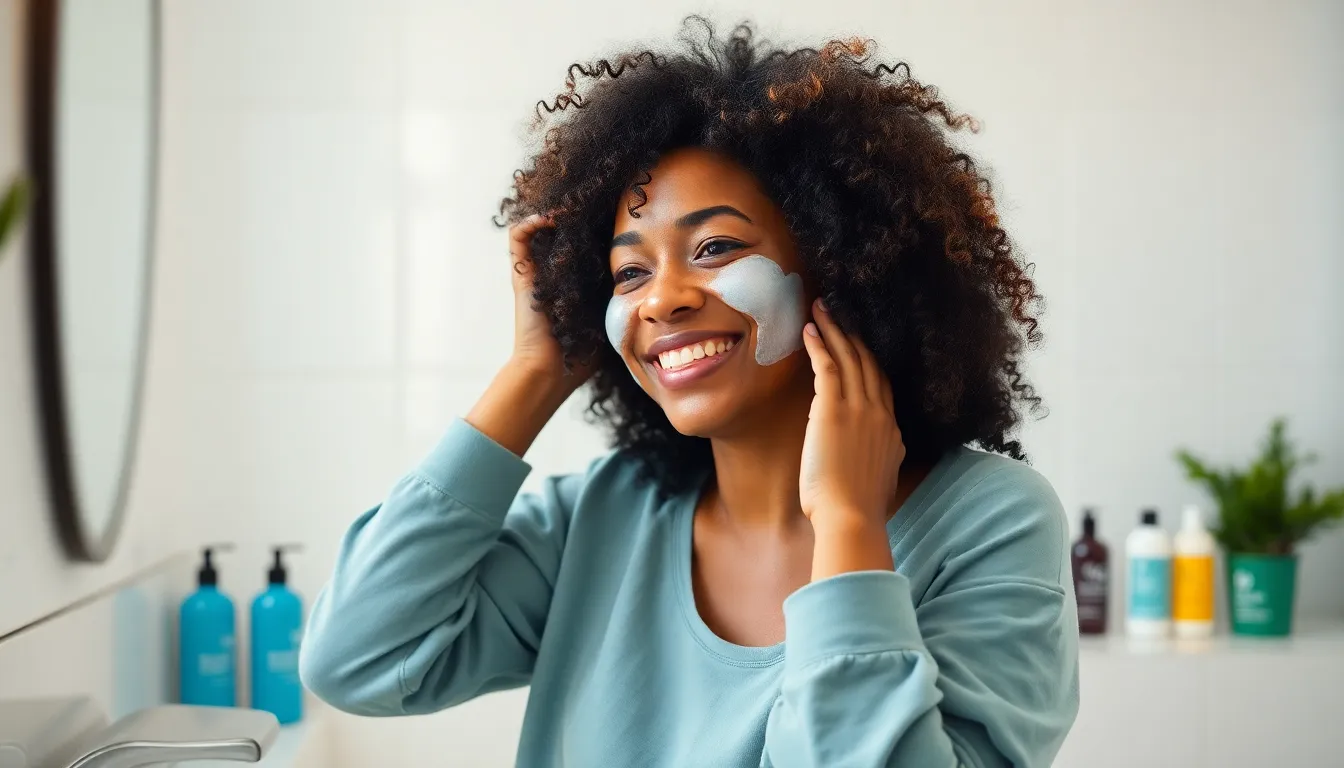
As our hair changes with age, we need to adapt our care routine to maintain healthy, vibrant curls. These essential techniques will help preserve moisture and enhance your natural curl pattern.
Proper Washing Techniques
Gentle cleansing becomes crucial for mature curly hair, which tends to be drier and more fragile than straight hair. We recommend using sulfate-free shampoos specifically formulated for curly hair, as these preserve natural oils that keep curls hydrated and defined. Frequency matters significantly – washing curly hair more than twice a week can strip away essential moisture and leave curls looking frizzy and brittle.
Focus your shampoo application on the scalp rather than the hair lengths, allowing the suds to gently cleanse the mid-lengths and ends as you rinse. Lukewarm water works best for washing curly hair, as hot water can cause cuticles to swell and create frizz. We suggest using your fingertips to massage the scalp in circular motions, promoting blood flow while avoiding harsh scrubbing that can damage delicate curl patterns.
Deep Conditioning Treatments
Weekly deep conditioning treatments become non-negotiable for maintaining healthy curls after 60, when hair naturally produces less sebum. These intensive treatments penetrate the hair shaft to restore moisture, improve elasticity, and reduce breakage that commonly affects aging curls. Apply your deep conditioning mask from mid-length to ends, avoiding the roots to prevent weighing down your hair.
Leave the treatment on for 15 to 20 minutes under a shower cap, allowing the heat to help ingredients penetrate deeper into the hair cuticle. We recommend choosing masks with ingredients like shea butter, argan oil, or keratin proteins that specifically target mature hair needs. Rinse thoroughly with cool water to seal the cuticle and lock in moisture, then gently squeeze out excess water with a microfiber towel to prevent breakage and frizz formation.
Conclusion
We believe that embracing your natural curls after 60 opens up a industry of stylish possibilities that celebrate both your beauty and individuality. The key lies in choosing cuts that work with your curl pattern while using the right products and techniques to maintain healthy vibrant hair.
Remember that confidence is your best accessory. Whether you opt for a classic bob a trendy pixie or an edgy asymmetrical cut your curls tell a story of authenticity and self-acceptance that’s truly beautiful.
We encourage you to experiment with different styles and find what makes you feel most confident. With proper care and the right approach your curls can be your signature look that turns heads and inspires others to embrace their natural texture too.
Frequently Asked Questions
Are curly hairstyles appropriate for women over 60?
Absolutely! Curly hairstyles are perfect for women over 60. Natural curls provide volume and body, which is especially beneficial as hair thins with age. Curly styles can soften angular features, blur fine lines, and draw attention to the eyes and cheekbones. They also require less styling time and heat damage compared to straight styles.
What are the best curly hairstyles for mature women?
The most flattering options include the classic curly bob, layered curly pixie cut, shoulder-length curly shag, curly lob (long bob), and short curly afro. Each style offers different benefits – from low maintenance pixies to versatile bobs that adapt to various face shapes and curl patterns.
How do I maintain curly hair after 60?
Focus on hydration and gentle care. Use sulfate-free shampoos, wash less frequently, and apply deep conditioning treatments weekly. Use moisturizing leave-in conditioners, curl-defining creams, and sleep on silk or satin pillowcases. Regular trims every 8-10 weeks help maintain shape and prevent split ends.
Can I add bangs to my curly hairstyle over 60?
Yes! Bangs can add youthful flair and draw attention to your eyes. Side-swept bangs are particularly versatile and enhance volume, while curly fringes offer customizable framing options. Use moisturizing products to maintain bangs and schedule regular trims to keep them looking fresh and well-shaped.
What products should I use for curly hair over 60?
Essential products include sulfate-free shampoos, curl-defining creams and gels, moisturizing leave-in conditioners, and heat protectants. Look for products with nourishing ingredients like shea butter and argan oil. Deep conditioning treatments should be used weekly to restore moisture and improve hair elasticity.
Are asymmetrical curly cuts suitable for mature women?
Definitely! Asymmetrical cuts add contemporary flair while maintaining sophistication. These styles create visual movement and dimension, making curls stand out beautifully. Asymmetrical bobs and tapered sides work particularly well with silver hair, offering a modern balance between embracing natural gray tones and stylish cutting-edge looks.
How often should I wash my curly hair after 60?
Wash curly hair less frequently than straight hair – typically 2-3 times per week or as needed. Over-washing strips natural oils that mature curly hair desperately needs. Use gentle, sulfate-free shampoos and focus on cleansing the scalp rather than the hair lengths to preserve moisture and curl definition.
